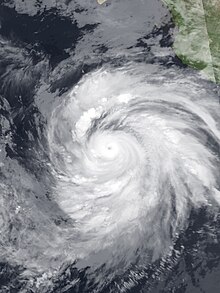It has been suggested that this article be merged into 2002 Pacific hurricane season. (Discuss) Proposed since October 2024. |
 Elida at peak intensity on July 25 | |
| Meteorological history | |
|---|---|
| Formed | July 23, 2002 |
| Remnant low | July 30, 2002 |
| Dissipated | July 31, 2002 |
| Category 5 major hurricane | |
| 1-minute sustained (SSHWS/NWS) | |
| Highest winds | 160 mph (260 km/h) |
| Lowest pressure | 921 mbar (hPa); 27.20 inHg |
| Overall effects | |
| Fatalities | None |
| Damage | None |
| IBTrACS | |
Part of the 2002 Pacific hurricane season | |
Hurricane Elida was the first of three tropical cyclones of the 2002 Pacific hurricane season to reach Category 5 strength on the Saffir-Simpson Hurricane Scale. Elida was one of only sixteen known Category 5 hurricanes in the eastern north Pacific tropical cyclone basin, east of the International Date Line and north of the Equator. Although heavy waves affected the Mexican coastline due to Elida, no damages or casualties were reported in relation to the hurricane.
Elida developed on July 23, 2002, to the southwest of Mexico. The hurricane moved westward due to a high pressure ridge while undergoing two eyewall replacement cycles: the first was around peak intensity and was completed when the hurricane moved over cooler waters, and the second was a brief cycle shortly after the hurricane began to weaken. The last advisory was issued while the hurricane was west of Mexico, but it was not until the remnants were west of Los Angeles, California that they finally dissipated. Elida's rapid intensification and unsteady weakening after reaching its peak intensity caused large errors in the intensity forecasting of the hurricane by the United States–based National Hurricane Center. Despite this, the track forecasts for Elida were better than usual compared to the prior ten–year average.